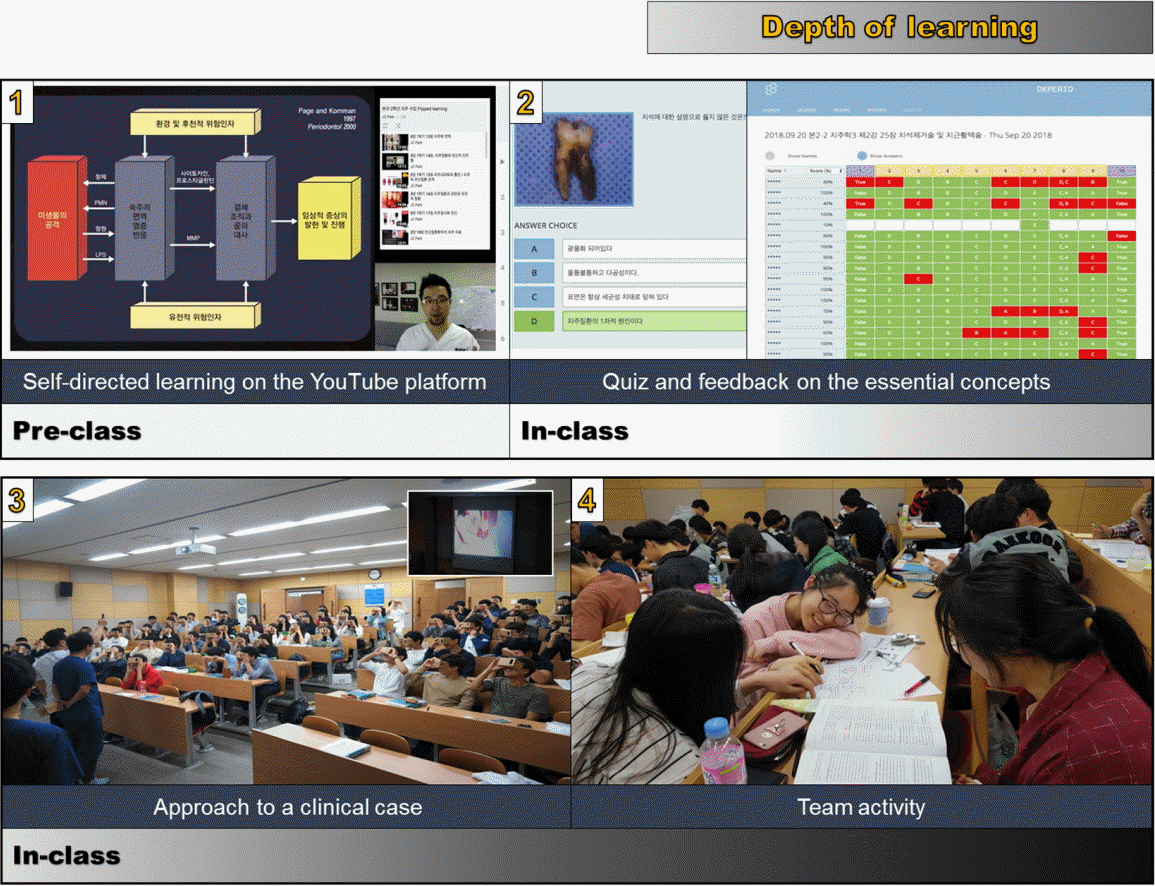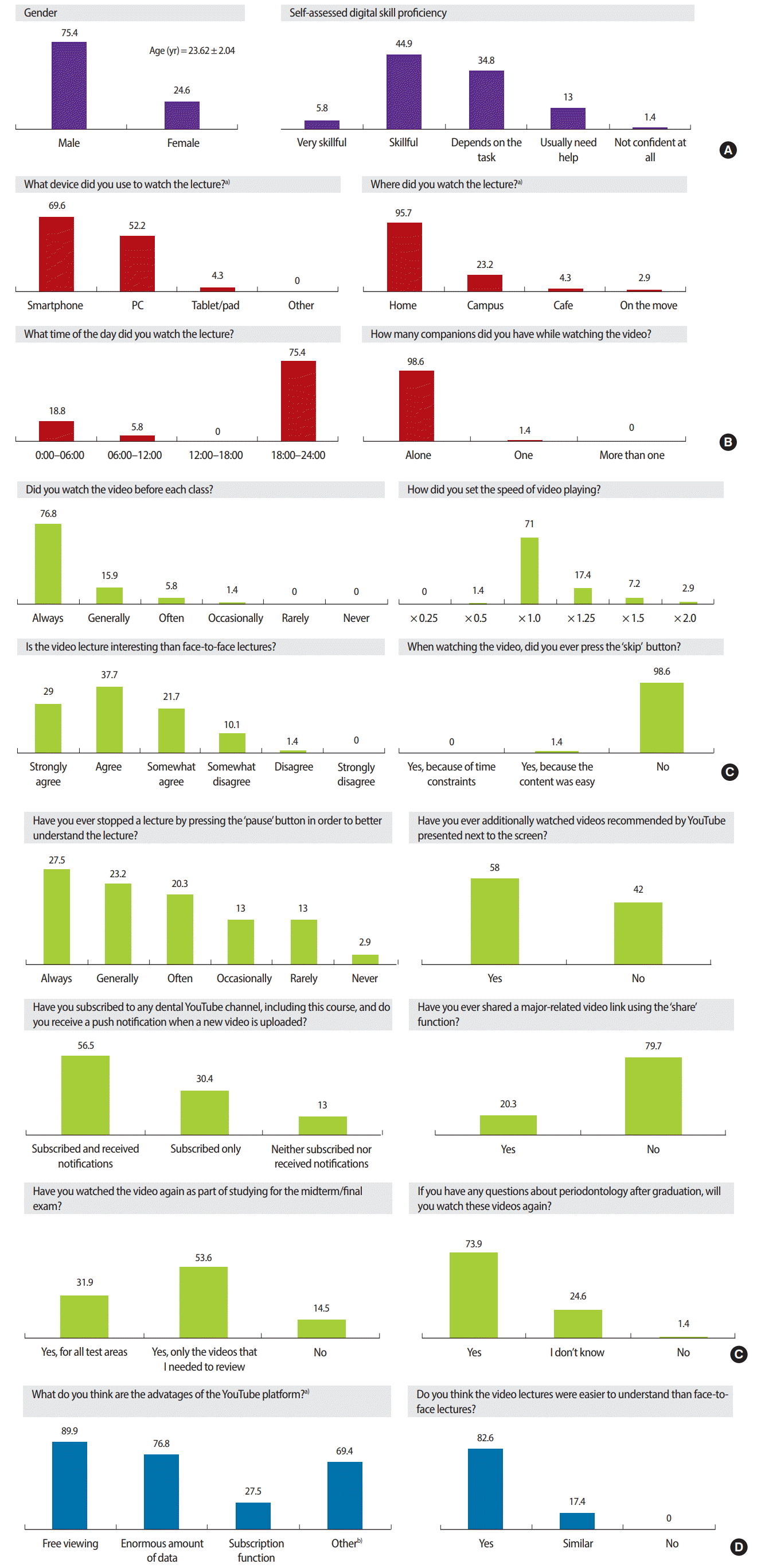Case
The participants were 69 second-year students of Dankook University College of Dentistry who attended a clinical periodontology course (52 males, 17 females). The periodontology course ran from March 2 to December 16, 2016. This course contained 1-hour weekly sessions, comprising a total of 14 hours. The instructor recorded the lecture videos using the Screencast application, which records the content of the presentations and the comments of the lecturer in real-time (Camtasia; TechSmith Corp., Okemos, MI, USA). The lecture videos were uploaded to YouTube before the class (
https://www.youtube.com/jcparkland), as shown in
Table 1 (
Supplement 1). On average, the micro-lecture videos did not exceed 20 minutes in consideration of the students’ ability to focus. Abstracts of all micro-lectures were also uploaded as PDF files. The links to the You-Tube videos and the PDF files were posted together using G Suite for Education (Google, Mountain View, CA, USA). The students completed pre-learning by watching micro-lecture videos on the YouTube platform and reading the PDF abstract before attending class, and their understanding of the content of the micro-lecture videos was assessed through an in-class quiz related to the pre-learning content. Students’ answers to the quiz were shared in real time on the screen using the smartphone application Socrative (
http://socrative.com) [
5], which is a cloud-based student response system. For topics for which students’ understanding was considered to be lacking, immediate feedback was provided by introducing major concepts. Through such a process, students could thoroughly learn the basic concepts that they needed to be aware of. After checking and complementing the pre-learning process through the quiz and feedback, theoretical perspectives and clinical practice were integrated by linking the content with treatment/surgery fields through Google Cardboard virtual reality (VR) and live surgery broadcasting. This process enhanced the acquisition of actual knowledge and promoted motivation to learn by helping students indirectly experience how the theories they learned were applied in clinical settings. Moreover, after the process, in-depth learning of corresponding topics was promoted through various team-based learning activities, such as debates, and projects. The details of the pre-class and in-class process are shown in
Fig. 1.
Fig. 1.
Implementation of the flipped classroom.


Table 1.
The list of lecture videos uploaded to YouTube over 2 semesters from March to December 2016

At the end of the second semester, the students were surveyed using the questionnaire devised by the authors. We developed a survey questionnaire to assess the students’ learning attitudes and the applicability of YouTube with a rubric, according to which each item was scored on a 6-point Likert scale. The questionnaire was developed by the researchers in advance and completed by consulting with 2 medical education experts. Students responded to the survey after the final examination using Google Forms with their smartphones in January 2017. We conducted a descriptive statistical analysis, including the frequency and percentage of answers. The raw data of this study are presented in
Supplement 2. The major results were as follows (
Fig. 2).
Fig. 2.
Descriptive statistics of the post-course survey items focusing on the learning experience using the YouTube platform. Values are presented as % or mean ± standard deviation. (A) Basic information. (B) Pre-learning environment. (C) Lecture viewing: learning attitude and awareness. (D) Assessment of the YouTube platform. PC, personal computer. a)Multiple selection; b)Sharing, virtual reality content, replay, feedback using comments, subtitles, and live streaming.


First, students usually watched the micro-lecture videos using smartphones (69.6%), at their home (95.7%) in the evening after school (75.4%), and they usually watched them alone (98.6%).
Second, almost all students came to class after watching the micro-lecture videos (92.7%), and they watched them at a speed within the normal range (range, × 1.0 to × 1.25; 88.4%), without using the skip function (98.6%), despite concerns. Sixty-seven students (97.1%) reported engaging in supplementary learning practices, such as returning to the previous stage after stopping the micro-lecture videos using the pause function of YouTube when they encountered difficulty in understanding while watching the lecture. In addition, many students reviewed the related micro-lecture videos to prepare for examinations (85.5%).
Third, 57 students preferred the micro-lecture videos because they perceived them to be more helpful for understanding class topics than offline lectures (82.6%), and 73.9% of the students reported that they intended to watch the videos again if they become curious about periodontology after graduation.
Fourth, regarding the functions of YouTube, 86.9% of the students subscribed to a YouTube channel related to their major, and as many as 58.0% of the students additionally watched the related videos that YouTube recommended, as well as the required micro-lecture videos their professor had uploaded. However, only 20.3% of the students reported having shared a video link with others.
Fifth, students stated that the YouTube platform had the advantage of allowing them to watch an enormous amount of data (76.8%) for free (89.9%), and YouTube functions such as VR content, replay, feedback using comments, subtitles, and live streaming helped their understanding.





 PDF
PDF Citation
Citation Print
Print





 XML Download
XML Download